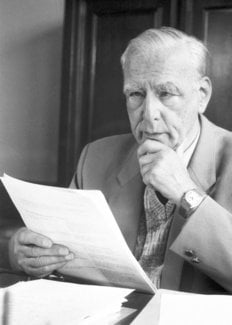Ernst Ruska
Biographical

I was born on 25 December 1906 in Heidelberg as the fifth of seven children of Professor Julius Ruska and his wife Elisbeth (née Merx). After graduating from grammar school in Heidelberg I studied electronics at the Technical College in Munich, studies which I began in the autumn of 1925 and continued two years later in Berlin. I received my practical training from Brown-Boveri & Co in Mannheim and Siemens & Halske Ltd in Berlin. Whilst still a student at the Technical College in Berlin I began my involvement with high voltage and vacuum technology at the Institute of High Voltage, whose director was Professor Adolf Matthias. Under the direct tutelage of Dr Max Knoll and together with other doctoral students I worked on the development of a high performance cathode ray oscilloscope. On the one hand my interest lay principally in the development of materials for the building of vacuum instruments according to the principles of construction; on the other it lay in continuing theoretical lectures and practical experiments in the optical behaviour of electron rays.
My first completed scientific work (1928-9) was concerned with the mathematical and experimental proof of Busch’s theory of the effect of the magnetic field of a coil of wire through which an electric current is passed and which is then used as an electron lens. During the course of this work I recognised that the focal length of the waves could be shortened by use of an iron cap. From this discovery the polschuh lens was developed, a lens which has been used since then in all magnetic high-resolution electron microscopes. Further work, conducted together with Dr Knoll, led to the first construction of an electron microscope in 1931. With this instrument two of the most important processes for image reproduction were introduced-the principles of emission and radiation. In 1933 I was able to put into use an electron microscope, built by myself, that for the first time gave better definition than a light microscope. In my Doctoral thesis of 1934 and for my university teaching thesis (1944), both at the Technical College in Berlin, I investigated the properties of electron lenses with short focal lengths.
Since the further technical development of electron microscopes could not be the task of a college institute – whose resources would have been far overstretched – I went to work in industry in the field of electron optics. From 1933 to 1937 I was with Fernseh Ltd in Berlin-Zehlendorf and was responsible for the development of television receivers and transmitters, as well as photoelectric cells with secondary amplification. Convinced of the great practical importance of electron microscopy for pure and applied research I attempted during this time to continue the development of high-resolution electron microscopes with larger materials, this time working with Dr Bodo von Borries. This work was made possible in 1936-7 by Siemens & Halske. In Berlin-Spandau in 1937 we set up the Laboratory for Electron Optics and developed there until 1939 the first customised electron microscopes (the ‘Siemens Super Microscope’). Parallel to the development of this instrument my brother, Dr Med. Helmut Ruska, and his colleagues worked on its application, particularly in the medical and biological fields. In order to promote its usage in different scientific areas as quickly as possible we suggested to Siemens that they set up a visiting institute for research work to be carried out using electron microscopy. This institute was founded in 1940. From this institute, in which we worked together with both German and foreign scientists, around 200 scientific papers were published before the end of 1944. My task consisted in the development and production of the electron microscope, such that by the beginning of 1945 around 35 institutions were equipped with one.
In the years following 1945 I, together with a majority of new colleagues, reconstituted the Institute of Electron Optics in Berlin-Siemensstadt, which had been disbanded due to bombing, so that by 1949 electron microscopes were again being built. This new period of development led in 1954 to ‘Elmiskop 1’, which since then has been used in over 1200 institutions the world over. At the same time I sought the further physical development of the electron microscope by working at other scientific institutions. Thus from August 1947 to December 1948 I worked at the German Academy of Sciences in Berlin-Buch in the Faculty of Medicine and Biology, then from January 1949 as Head of Department at what is today the Fritz Haber Institute of the Max Planck Society in Berlin-Dahlem. Here on 27 June 1957 I was made Director of the Institute for Electron Microscopy, after I had given up my position with Siemens in 1955. I retired on 31 December 1974.
From 1949 until 1971 I held lectures on the basic principles of electron optics and electron microscopy at both the Free University and the Technical University of Berlin. My publications in the area of electron optics and electron microscopy include several contributions to books and over 100 original scientific papers.
(added by the editor): Ernst Ruska died on May 25, 1988.
This autobiography/biography was written at the time of the award and first published in the book series Les Prix Nobel. It was later edited and republished in Nobel Lectures. To cite this document, always state the source as shown above.
Nobel Prizes and laureates
Six prizes were awarded for achievements that have conferred the greatest benefit to humankind. The 14 laureates' work and discoveries range from quantum tunnelling to promoting democratic rights.
See them all presented here.
